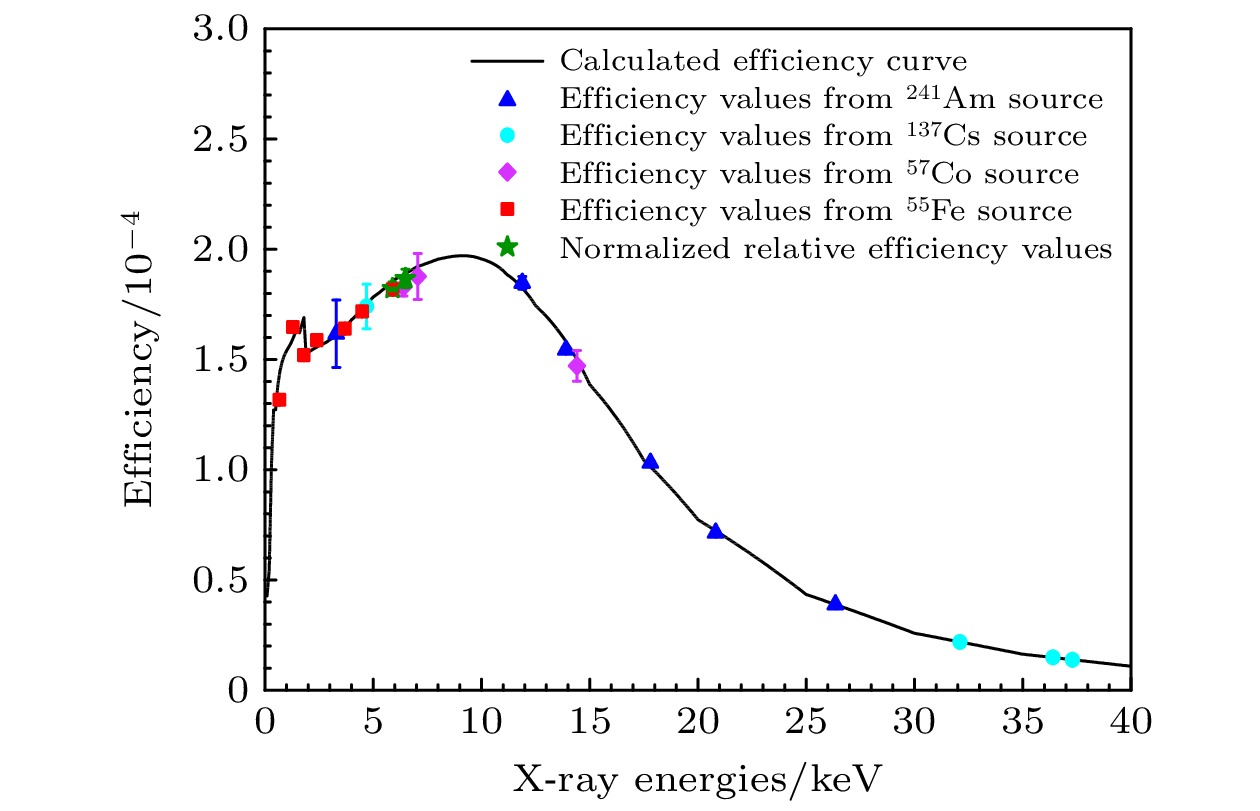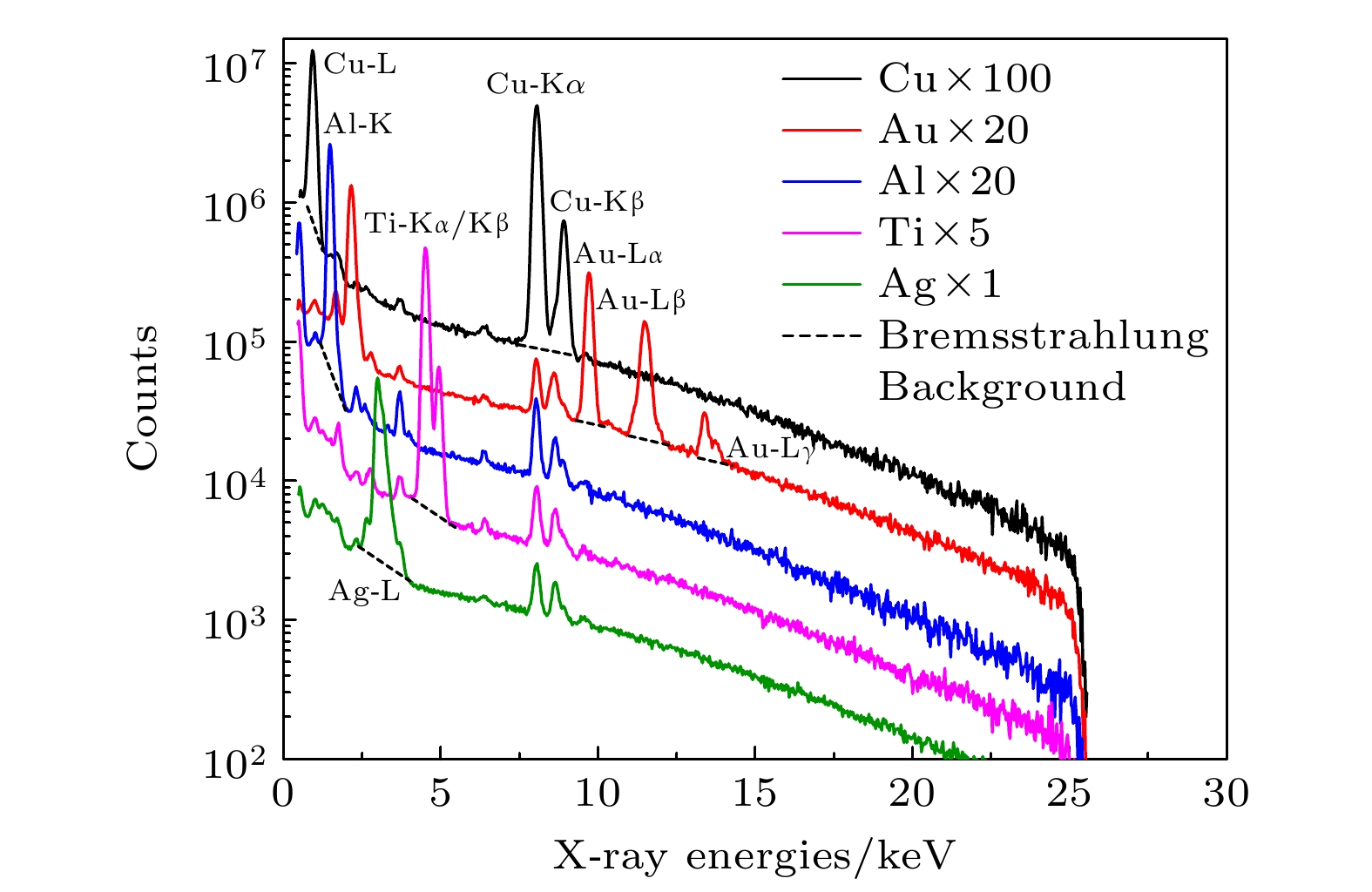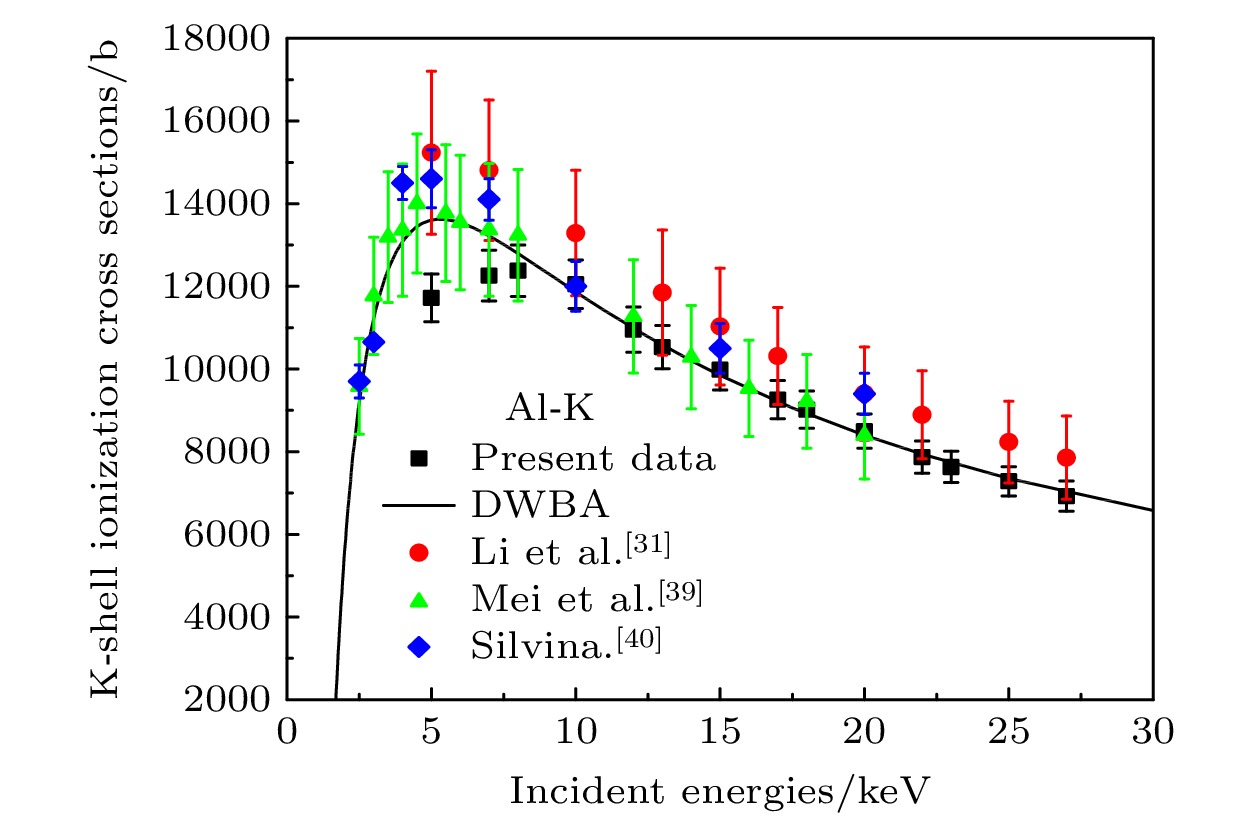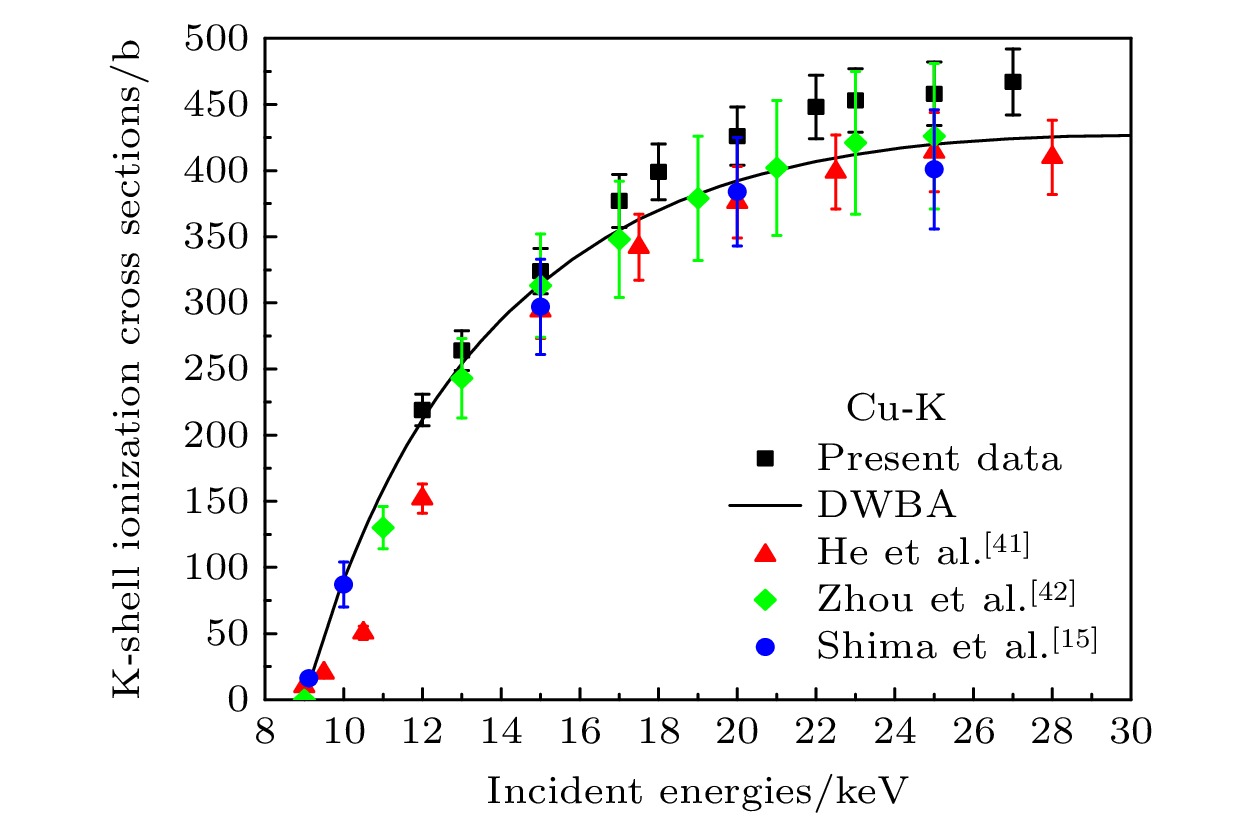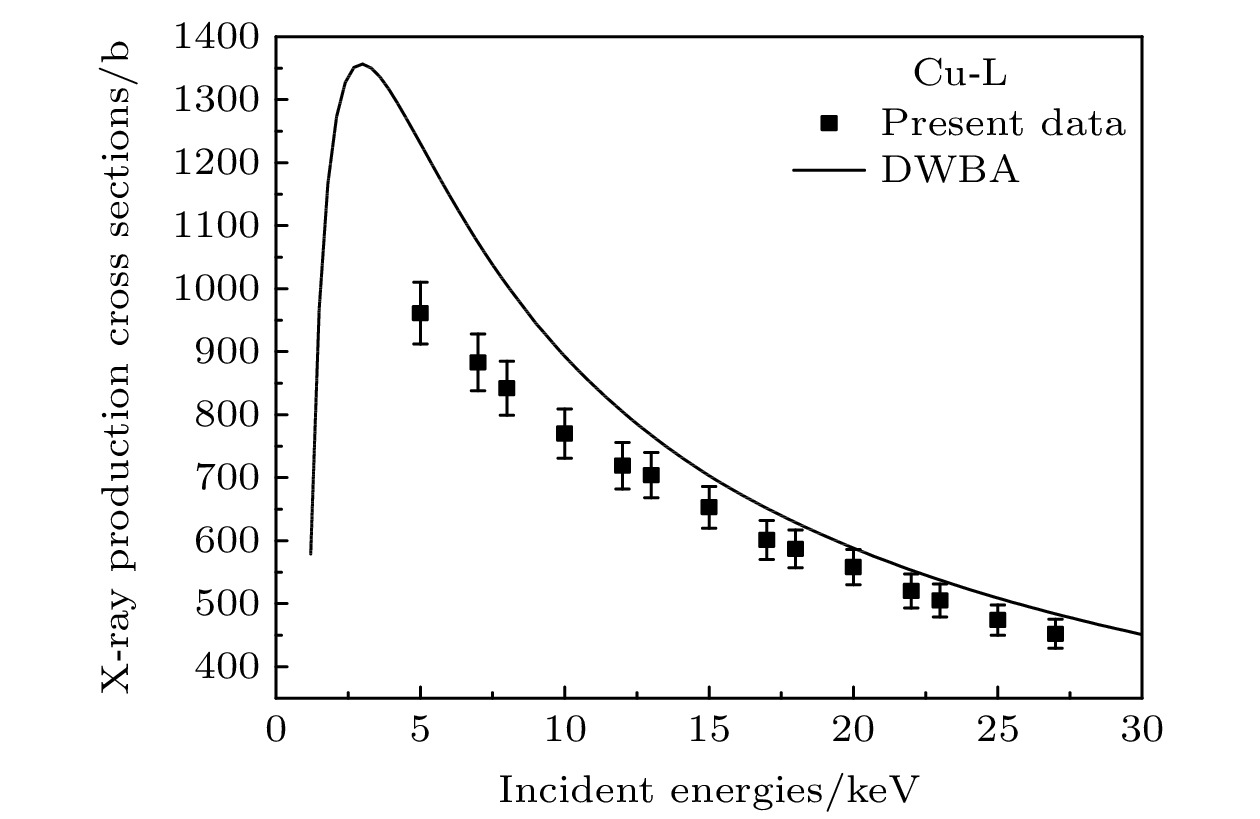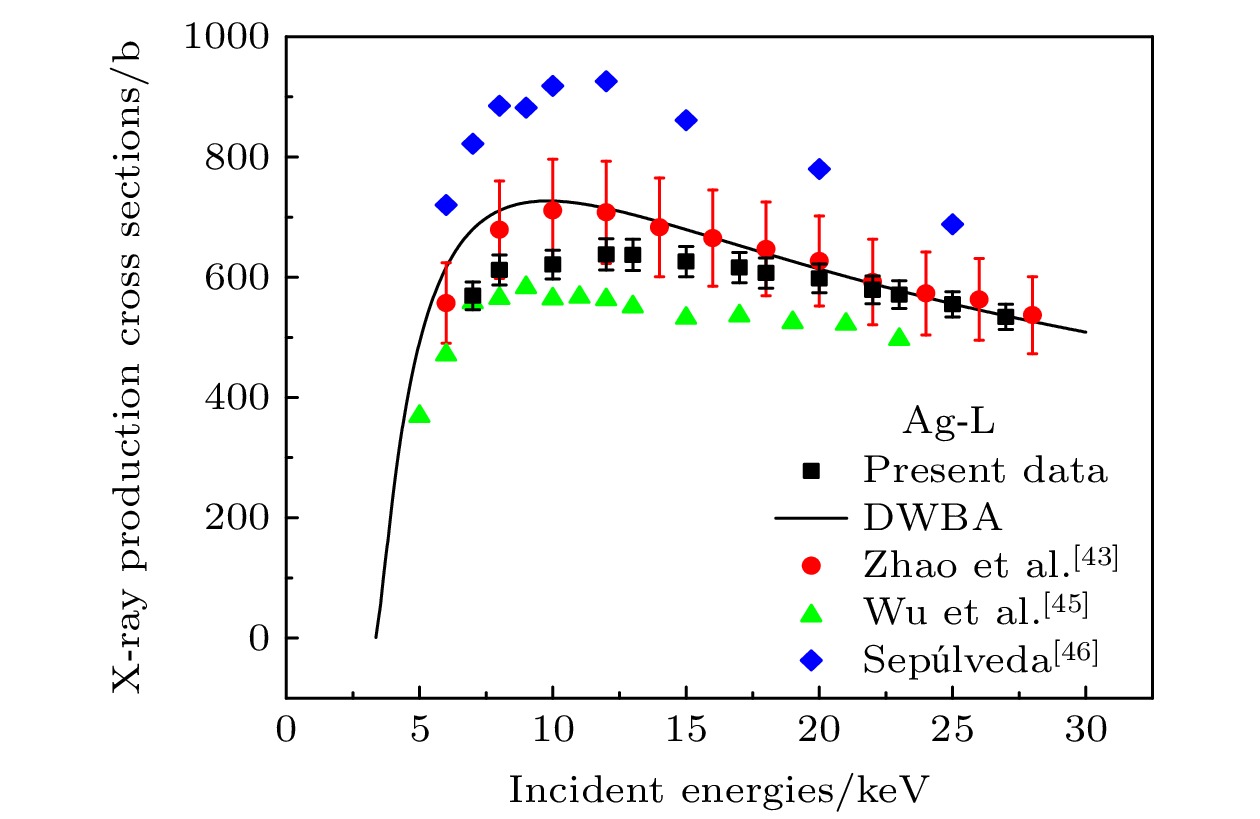-
使用5—27 keV能量范围内的单能电子束轰击薄碳衬底上的薄Al (Z = 13), Ti (Z = 22), Cu (Z = 29), Ag (Z = 47), Au(Z = 79)靶, 使用硅漂移型探测器(SDD)收集产生的特征X射线, 测量了Al, Ti, Cu的K壳层电离截面以及Cu, Ag和Au的L壳层特征X射线的产生截面, 并且使用蒙特卡罗PENELOPE程序对实验结果进行了修正. 本文给出了Cu的L壳层特征X射线产生截面. 与半相对论扭曲波玻恩近似(semi-relativistic distorted-wave Born approximation, DWBA)理论值相比, 本文的大多数实验值在7%的范围内与理论值符合. 研究表明, 中重元素的L壳电离截面的理论计算以及相应的原子参数有待更精确的确定.The K-shell ionization cross sections of Al, Ti, Cu and L-shell characteristic X-ray production cross sections of Cu, Ag and Au (Lα, Lβ and Lγ subshells for Au) by electron impact at incident energy of 5–27 keV are determined experimentally. Thin films of the studied elements, deposited on thin carbon substrates, are employed as targets in the experiments. The thickness of the thin carbon substrate is 7 μg/cm2, the targets are Al, Ti, Cu, Ag and Au and their thickness values are 5.5 μg/cm2, 28 μg/cm2, Cu 35.5 μg/cm2, 44 μg/cm2 and 44 μg/cm2, respectively. The target thickness values are checked by using Rutherford Backscattering Spectrometry (RBS). The electron beam is provided by a scanning electron microscope (KYKY-2800B). The characteristic X-rays produced are recorded by a silicon drifted detector (XR-100SDD, Amptek), which has a C2 ultrathin window and can detect the low-energy X-rays down to boron Kα line (0.183 keV). The detector efficiency is calibrated by using the standard sources (55Fe, 57Co, 137Cs and 241Am) for X-ray energy larger than 3.3 keV while using the characteristic peak method (i.e. by measuring characteristic X-ray spectra produced by 20 keV electron impacting various thick solid targets) for X-ray energy less than 3.3 keV. The experimental results are corrected by the Monte Carlo code PENELOPE for the effects of target structure and Faraday cup. Meanwhile, the electron escape rates obtained from the Faraday cup and the signal pile-up effect are also considered. The results show that when the incident electron energy is low, the influences of electron energy loss and target thickness are significant. The thinner the target , the smaller the correction is. Experimental uncertainties for K-shell ionization cross sections of Al, Ti and Cu are about 5.0%, 5.6% and 5.1%, respectively; experimental uncertainties for L-shell X-ray production cross sections for Cu and Ag are about 5.3% and 4.0%, and for Lα,Lβ,and Lγ of Au are about 6.1%, 8.9% and 11.0%, respectively. The experimental L-shell characteristic X-ray production cross sections of Cu are given for the first time. Compared with the theoretical values of the semi-relativistic distorted-wave Born approximation (DWBA), most of the experimental values in this work are in good agreement within 7% deviation. The best agreement between the experimental results and the theoretical values is obtained for the K shell ionization cross section of Al, and the deviation is less than 1.7% for the data where the incident energy is above 10 keV. The least consistency with the theoretical values is the experimental L shell characteristic X-ray production cross sections of Cu, with a deviation being about 5–22%. The comparison of the experimental L shell characteristic X-ray production cross sections of Cu (including Ga and As elements) with those from the DWBA theory indicates that the theoretical calculations of L shell ionization cross sections of medium heavy elements and the corresponding atomic parameters (such as fluorescence yields and Coster-Kronig transition probabilities) need to be more accurately determined. According to the present results, the ionization cross sections or characteristic X-ray production cross sections measured by the thin target thin substrate, the thin target thick substrate and the thick target methods are equivalent to each other within the uncertainties.
-
Keywords:
- atomic inner-shell ionization /
- characteristic X-ray /
- cross section /
- Monte Carlo simulation
[1] Powell C J 1976 Rev. Mod. Phys. 48 33
 Google Scholar
Google Scholar
[2] Zhao J L, An Z, Zhu J J, Tan W J, Liu M T 2016 J. Phys. B: At. Mol. Opt. Phys. 49 065205
 Google Scholar
Google Scholar
[3] Born M 1926 Z. Physik 38 803
 Google Scholar
Google Scholar
[4] Truhlar D O, Rice J K, Kuppermann A, Trajmar S 1970 Phys. Rev. A 1 778
 Google Scholar
Google Scholar
[5] Shelton W N, Leherissey E S, Madison D H 1971 Phys. Rev. A 3 242
 Google Scholar
Google Scholar
[6] Madison D H, Shelton W N 1973 Phys. Rev. A 7 499
 Google Scholar
Google Scholar
[7] Rainer H 1990 Phys. Lett. A 144 81
[8] Bely O, Schmartz S B 1969 Astron. Astrophys. 1 281
[9] Sampson D H 1986 Phys. Rev. A 34 986
 Google Scholar
Google Scholar
[10] Fontes C J 1993 Phys. Rev. A 47 1009
 Google Scholar
Google Scholar
[11] Segui S, Dingfelder M, Salvat F 2003 Phys. Rev. A 67 062710
 Google Scholar
Google Scholar
[12] Colgan J, Fontes C J, Zhang H L 2006 Phys. Rev. A 73 062711
 Google Scholar
Google Scholar
[13] Bote D, Salvat F 2008 Phys. Rev. A 77 042701
 Google Scholar
Google Scholar
[14] Llovet X, Powell C J, Salvat F, Jablonski A 2014 J. Phys. Chem. Ref. Data 43 013102
 Google Scholar
Google Scholar
[15] Shima K, Nakagawa T, Umetani K, Mikumo T 1981 Phys. Rev. A 24 72
 Google Scholar
Google Scholar
[16] Shima K, Okuda M, Suzuki E, Tsubota T, Mikumo T 1983 J. Appl. Phys. 54 1202
 Google Scholar
Google Scholar
[17] Llovet X, Merlet C, Salvat F 2000 J. Phys. B:At. Mol. Opt. Phys. 33 3761
 Google Scholar
Google Scholar
[18] Bote D, Llovet X, Salvat F 2008 J. Phys. D:Appl. Phys. 41 105304
 Google Scholar
Google Scholar
[19] Moy A, Merlet C, Llovet X, Dugne O 2013 J. Phys. B:At. Mol. Opt. Phys. 46 115202
 Google Scholar
Google Scholar
[20] Qian Z C, Wu Y, Chang C H, Yuan Y, Mei C S, Zhu J J, Moharram K 2017 EPL 118 13001
 Google Scholar
Google Scholar
[21] Liang S, Wu Y, Zhao Z, Xia X G, Ke Z X, Pan M, Wang B Y, Zhang P 2021 Radiat. Phys. Chem. 180 109321
 Google Scholar
Google Scholar
[22] Merlet C, Llovet X, Fernandez-Varea J M 2006 Phys. Rev. A 73 062719
 Google Scholar
Google Scholar
[23] Merlet C, Llovet X, Salvat F 2004 Phys. Rev. A 69 032708
 Google Scholar
Google Scholar
[24] An Z, Li T H, Wang L M, Xia X Y, Luo Z M 1996 Phys. Rev. A 54 3067
 Google Scholar
Google Scholar
[25] Luo Z M, An Z, He F Q, Li T H, Long X G, Peng X F 1996 J. Phys. B:At. Mol. Opt. Phys. 29 4001
 Google Scholar
Google Scholar
[26] Zhao J L, An Z, Zhu J J, Tan W J, Liu M T 2017 Radiat. Phys. Chem. 134 71
 Google Scholar
Google Scholar
[27] Zhao J L, Bai S, An Z, Zhu J J, Tan W J, Liu M T 2020 Radiat. Phys. Chem. 171 108722
 Google Scholar
Google Scholar
[28] Zhu J J, An Z, Liu M T, Tian L X 2009 Phys. Rev. A 79 052710
 Google Scholar
Google Scholar
[29] Zhao J L, Tian L X, Li X L, An Z, Zhu J J, Liu M T 2015 Radiat. Phys. Chem. 107 47
 Google Scholar
Google Scholar
[30] Wu Y, Liang Y, Xu M X, Yuan Y, Chang C H, Qian Z C, Wang B Y, Kuang P, Zhang P 2018 Phys. Rev. A 97 032702
 Google Scholar
Google Scholar
[31] 李颖涵, 安竹, 朱敬军, 李玲 2020 物理学报 69 133401
 Google Scholar
Google Scholar
Li Y H, An Z, Zhu J J, Li L 2020 Acta Phys. Sin. 69 133401
 Google Scholar
Google Scholar
[32] Li L, An Z, Zhu J J, Lin W P, Williams S 2021 Nucl. Instrum. Methods Phys. Res. B 506 15
 Google Scholar
Google Scholar
[33] 樊启文, 许国基, 杜英辉, 张榕 2008 原子能科学技术 42 925
Fan Q W, Xu G J, Du Y H, Zhang R 2008 Atom. Energ. Sci. Technol 42 925
[34] Han J F, An Z, Zheng G Q, Bai F, Li Z H, Wang P, Liao X D, Liu M T, Chen S L, Song M J 2018 Nucl. Instrum. Methods Phys. Res. B 418 68
 Google Scholar
Google Scholar
[35] Liu B, Ding W, An Z, Zhu J J, Zhang Z, Li L, Lin W P 2021 Fusion Eng. Des. 172 112751
 Google Scholar
Google Scholar
[36] Sabbatucci L, Scot V, Fernandez J E 2014 Radiat. Phys. Chem. 104 372
 Google Scholar
Google Scholar
[37] Salvat F, Fernández-Varea J, Sempau J 2008 PENELOPE-2008, A Code System for Monte Carlo Simulation of Electron and Photon Transport (Issy-les-Moulineau: OECD/NEA Data Bank)
[38] Perkins S T, Cullen D E, Chen M H, Hubbell J H, Rathkopf J, Scofield J 1991 Report UCRL-50400 30 Lawrence Livermore National Laboratory, Livermore, CA
[39] Mei C S, Wu Y, Yuan Y, Chang C H, Qian Z C, Zhu J J, Moharram K 2016 J. Phys. B: At. Mol. Opt. Phys. 49 245204
[40] Silvina P L, Vasconcellos M A Z, Ruth H, Jorge C T 2012 Phys. Rev. A 86 042701
 Google Scholar
Google Scholar
[41] He F Q, Peng X F, Long X G, Luo Z M, An Z 1997 Nucl. Instrum. Methods Phys. Res. B 129 445
 Google Scholar
Google Scholar
[42] 周长庚, 付玉川, 安竹, 罗正明 2000 强激光与粒子束 12 601
Zhou C G, Fu Y C, An Z, Luo Z M 2000 High Power Laser and Particle Beams 12 601
[43] Zhao J L, An Z, Zhu J J, Tan W J, Liu M T 2016 Radiat. Phys. Chem. 122 66
 Google Scholar
Google Scholar
[44] Campbell J L 2003 At. Data Nucl. Data Tables 85 291
 Google Scholar
Google Scholar
[45] Wu Y, An Z, Liu M T, Duan Y M, Tang C H, Luo Z M 2004 J. Phys. B:At. Mol. Opt. Phys. 37 4527
 Google Scholar
Google Scholar
[46] Sepúlveda A, Bertol A P, Vasconcellos M A Z, Trincavelli J, Hinrichs R, Castellano G 2014 J. Phys. B:At. Mol. Opt. Phys. 47 215006
 Google Scholar
Google Scholar
[47] Campos C S, Vasconcellos M A Z 2002 Phys. Rev. A 66 012719
 Google Scholar
Google Scholar
-
图 3 从上到下分别是能量为25 keV的电子束碰撞Cu, Au, Al, Ti, Ag 5种薄靶产生的X射线谱, 元素×N中的N为对应谱放大倍数, 虚线是轫致辐射本底
Fig. 3. The experimental spectra for Cu, Au, Al, Ti, Ag target by 25 keV electron impact (from the top to the bottom). N in element ×N is the magnification of the corresponding spectrum. The dotted line is the bremsstrahlung background.
图 10 能量为13—25 keV的电子碰撞Au靶L壳层特征X射线产生截面. 从上到下分别是Lα, Lβ和Lγ子壳层. 其中, 实心形状为实验值; 实线为DWBA理论值
Fig. 10. The Lα, Lβ and Lγ shell characteristic X-ray production cross sections of Au target by 13–25 keV electron impact (from top to bottom). The solid shapes are the experimental values. The solid line is DWBA theoretical value.
表 1 靶原子K壳层荧光产额及X射线分支比(提取自PENELOPE程序数据库)
Table 1. Fluorescence yields and X-ray branching ratios of K shell of target atoms (extracted from PENELOPE program database).
Elements Fluorescence yields X-ray branching ratios ωK FKα FKβ Al 0.0371 0.9939 0.0061 Ti 0.2135 0.8979 0.1021 Cu 0.4338 0.8916 0.1084 表 2 靶原子L壳层荧光产额及Coster-Kronig跃迁概率(提取自PENELOPE程序数据库)
Table 2. Fluorescence yields and Coster-Kronig transition coefficients of L shell of target atoms (extracted from PENELOPE program database).
Elements Fluorescence yields Coster-Kronig transition coefficients ωL1 ωL2 ωL3 f12 f13 f23 Cu 0.0019 0.0092 0.0088 0.2402 0.5722 0.0089 Ag 0.0149 0.0547 0.0570 0.0921 0.6646 0.1604 Au 0.0823 0.3627 0.3183 0.0700 0.7034 0.1285 表 3 靶原子L壳层X射线分支比(提取自PENELOPE程序数据库)
Table 3. X-ray branching ratios of L shell of target atoms (extracted from PENELOPE program database).
Elements X-ray branching ratios F3α F1β F2β F3β F1γ F2γ Cu 0.4933 0.9430 0.4821 0.0121 0.0000 0.0131 Ag 0.8159 0.8391 0.8509 0.0814 0.1494 0.0862 Au 0.7822 0.7466 0.7989 0.1702 0.2227 0.1786 表 4 Al, Ti, Cu的K壳层电离截面实验结果
Table 4. Experimental results of K shell ionization cross sections of Al, Ti and Cu.
Incident energies/keV K-shell ionization cross sections and uncertainties/b Al Ti Cu 5 11720 ±580 7 12261 ±616 689 ±41 8 12378 ±621 898 ±53 10 12050 ±588 993 ±55 151 ±8 12 10952 ±546 1149 ±64 219 ±12 13 10526 ±523 1191 ±67 264 ±15 15 9982 ±488 1211 ±67 324 ±17 17 9258 ±461 1236 ±69 377 ±20 18 9019 ±449 1240 ±70 399 ±21 20 8495 ±415 1256 ±70 426 ±22 22 7866 ±390 1248 ±70 448 ±24 23 7629 ±379 1243 ±69 453 ±24 25 7283 ±355 1232 ±68 458 ±24 27 6923 ±363 467 ±25 表 5 Cu, Ag和Au的L壳层特征X射线产生截面实验结果
Table 5. Experimental results of L shell characteristic X-ray production cross sections of Cu, Ag and Au.
Incident energies/keV L-shell X-ray production cross sections and uncertainties/b Cu Ag Au-Lα Au-Lβ Au-Lγ 5 961 ±49 7 883 ±45 569 ±23 8 842 ±43 612 ±25 10 770 ±39 621 ±24 12 719 ±37 638 ±26 13 704 ±36 637 ±26 36.9 ±2.9 11.3 ±1.9 15 653 ±33 626 ±25 79.1 ±4.4 34.5 ±2.5 17 601 ±31 616 ±25 112.9 ±6.8 64.4 ±4.6 18 587 ±30 607 ±25 130.5 ±8.0 76.0 ±5.5 20 558 ±28 598 ±24 148.7 ±8.3 86.4 ±5.2 11.6 ±1.3 22 520 ±27 579 ±23 161.8 ±9.5 100.5 ±6.6 13.6 ±1.8 23 505 ±26 571 ±23 168.8 ±10.0 100.2 ±6.5 13.8 ±1.8 25 474 ±24 555 ±21 178.1 ±9.5 110.9 ±6.1 16.3 ±1.4 27 452 ±23 534 ±21 -
[1] Powell C J 1976 Rev. Mod. Phys. 48 33
 Google Scholar
Google Scholar
[2] Zhao J L, An Z, Zhu J J, Tan W J, Liu M T 2016 J. Phys. B: At. Mol. Opt. Phys. 49 065205
 Google Scholar
Google Scholar
[3] Born M 1926 Z. Physik 38 803
 Google Scholar
Google Scholar
[4] Truhlar D O, Rice J K, Kuppermann A, Trajmar S 1970 Phys. Rev. A 1 778
 Google Scholar
Google Scholar
[5] Shelton W N, Leherissey E S, Madison D H 1971 Phys. Rev. A 3 242
 Google Scholar
Google Scholar
[6] Madison D H, Shelton W N 1973 Phys. Rev. A 7 499
 Google Scholar
Google Scholar
[7] Rainer H 1990 Phys. Lett. A 144 81
[8] Bely O, Schmartz S B 1969 Astron. Astrophys. 1 281
[9] Sampson D H 1986 Phys. Rev. A 34 986
 Google Scholar
Google Scholar
[10] Fontes C J 1993 Phys. Rev. A 47 1009
 Google Scholar
Google Scholar
[11] Segui S, Dingfelder M, Salvat F 2003 Phys. Rev. A 67 062710
 Google Scholar
Google Scholar
[12] Colgan J, Fontes C J, Zhang H L 2006 Phys. Rev. A 73 062711
 Google Scholar
Google Scholar
[13] Bote D, Salvat F 2008 Phys. Rev. A 77 042701
 Google Scholar
Google Scholar
[14] Llovet X, Powell C J, Salvat F, Jablonski A 2014 J. Phys. Chem. Ref. Data 43 013102
 Google Scholar
Google Scholar
[15] Shima K, Nakagawa T, Umetani K, Mikumo T 1981 Phys. Rev. A 24 72
 Google Scholar
Google Scholar
[16] Shima K, Okuda M, Suzuki E, Tsubota T, Mikumo T 1983 J. Appl. Phys. 54 1202
 Google Scholar
Google Scholar
[17] Llovet X, Merlet C, Salvat F 2000 J. Phys. B:At. Mol. Opt. Phys. 33 3761
 Google Scholar
Google Scholar
[18] Bote D, Llovet X, Salvat F 2008 J. Phys. D:Appl. Phys. 41 105304
 Google Scholar
Google Scholar
[19] Moy A, Merlet C, Llovet X, Dugne O 2013 J. Phys. B:At. Mol. Opt. Phys. 46 115202
 Google Scholar
Google Scholar
[20] Qian Z C, Wu Y, Chang C H, Yuan Y, Mei C S, Zhu J J, Moharram K 2017 EPL 118 13001
 Google Scholar
Google Scholar
[21] Liang S, Wu Y, Zhao Z, Xia X G, Ke Z X, Pan M, Wang B Y, Zhang P 2021 Radiat. Phys. Chem. 180 109321
 Google Scholar
Google Scholar
[22] Merlet C, Llovet X, Fernandez-Varea J M 2006 Phys. Rev. A 73 062719
 Google Scholar
Google Scholar
[23] Merlet C, Llovet X, Salvat F 2004 Phys. Rev. A 69 032708
 Google Scholar
Google Scholar
[24] An Z, Li T H, Wang L M, Xia X Y, Luo Z M 1996 Phys. Rev. A 54 3067
 Google Scholar
Google Scholar
[25] Luo Z M, An Z, He F Q, Li T H, Long X G, Peng X F 1996 J. Phys. B:At. Mol. Opt. Phys. 29 4001
 Google Scholar
Google Scholar
[26] Zhao J L, An Z, Zhu J J, Tan W J, Liu M T 2017 Radiat. Phys. Chem. 134 71
 Google Scholar
Google Scholar
[27] Zhao J L, Bai S, An Z, Zhu J J, Tan W J, Liu M T 2020 Radiat. Phys. Chem. 171 108722
 Google Scholar
Google Scholar
[28] Zhu J J, An Z, Liu M T, Tian L X 2009 Phys. Rev. A 79 052710
 Google Scholar
Google Scholar
[29] Zhao J L, Tian L X, Li X L, An Z, Zhu J J, Liu M T 2015 Radiat. Phys. Chem. 107 47
 Google Scholar
Google Scholar
[30] Wu Y, Liang Y, Xu M X, Yuan Y, Chang C H, Qian Z C, Wang B Y, Kuang P, Zhang P 2018 Phys. Rev. A 97 032702
 Google Scholar
Google Scholar
[31] 李颖涵, 安竹, 朱敬军, 李玲 2020 物理学报 69 133401
 Google Scholar
Google Scholar
Li Y H, An Z, Zhu J J, Li L 2020 Acta Phys. Sin. 69 133401
 Google Scholar
Google Scholar
[32] Li L, An Z, Zhu J J, Lin W P, Williams S 2021 Nucl. Instrum. Methods Phys. Res. B 506 15
 Google Scholar
Google Scholar
[33] 樊启文, 许国基, 杜英辉, 张榕 2008 原子能科学技术 42 925
Fan Q W, Xu G J, Du Y H, Zhang R 2008 Atom. Energ. Sci. Technol 42 925
[34] Han J F, An Z, Zheng G Q, Bai F, Li Z H, Wang P, Liao X D, Liu M T, Chen S L, Song M J 2018 Nucl. Instrum. Methods Phys. Res. B 418 68
 Google Scholar
Google Scholar
[35] Liu B, Ding W, An Z, Zhu J J, Zhang Z, Li L, Lin W P 2021 Fusion Eng. Des. 172 112751
 Google Scholar
Google Scholar
[36] Sabbatucci L, Scot V, Fernandez J E 2014 Radiat. Phys. Chem. 104 372
 Google Scholar
Google Scholar
[37] Salvat F, Fernández-Varea J, Sempau J 2008 PENELOPE-2008, A Code System for Monte Carlo Simulation of Electron and Photon Transport (Issy-les-Moulineau: OECD/NEA Data Bank)
[38] Perkins S T, Cullen D E, Chen M H, Hubbell J H, Rathkopf J, Scofield J 1991 Report UCRL-50400 30 Lawrence Livermore National Laboratory, Livermore, CA
[39] Mei C S, Wu Y, Yuan Y, Chang C H, Qian Z C, Zhu J J, Moharram K 2016 J. Phys. B: At. Mol. Opt. Phys. 49 245204
[40] Silvina P L, Vasconcellos M A Z, Ruth H, Jorge C T 2012 Phys. Rev. A 86 042701
 Google Scholar
Google Scholar
[41] He F Q, Peng X F, Long X G, Luo Z M, An Z 1997 Nucl. Instrum. Methods Phys. Res. B 129 445
 Google Scholar
Google Scholar
[42] 周长庚, 付玉川, 安竹, 罗正明 2000 强激光与粒子束 12 601
Zhou C G, Fu Y C, An Z, Luo Z M 2000 High Power Laser and Particle Beams 12 601
[43] Zhao J L, An Z, Zhu J J, Tan W J, Liu M T 2016 Radiat. Phys. Chem. 122 66
 Google Scholar
Google Scholar
[44] Campbell J L 2003 At. Data Nucl. Data Tables 85 291
 Google Scholar
Google Scholar
[45] Wu Y, An Z, Liu M T, Duan Y M, Tang C H, Luo Z M 2004 J. Phys. B:At. Mol. Opt. Phys. 37 4527
 Google Scholar
Google Scholar
[46] Sepúlveda A, Bertol A P, Vasconcellos M A Z, Trincavelli J, Hinrichs R, Castellano G 2014 J. Phys. B:At. Mol. Opt. Phys. 47 215006
 Google Scholar
Google Scholar
[47] Campos C S, Vasconcellos M A Z 2002 Phys. Rev. A 66 012719
 Google Scholar
Google Scholar
计量
- 文章访问数: 9873
- PDF下载量: 122
- 被引次数: 0














 下载:
下载:
